 I recently was doing some research on different types of leg wraps and boots for horses, and found that there is a lot of information out there, but it is scattered and not easy to find in one place. I think there are a lot of people out there who may look at boots the way poor Hamlet is looking at the boots in the photo to the right: with deep-seated confusion, and maybe more than a little revulsion for my terrible Photoshop job.
I recently was doing some research on different types of leg wraps and boots for horses, and found that there is a lot of information out there, but it is scattered and not easy to find in one place. I think there are a lot of people out there who may look at boots the way poor Hamlet is looking at the boots in the photo to the right: with deep-seated confusion, and maybe more than a little revulsion for my terrible Photoshop job.
Thankfully, it’s not too complicated! I have collected a lot of the basics of the most common types of boots right here. Thus, if you are asking, “to boot or not to boot?” – then let me help answer your question.
Polo Wraps
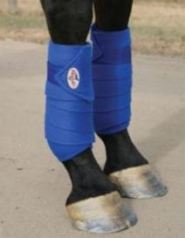 Polo wraps are very commonly used because they are affordable and come in many different colors. Polo wraps are long strips of fleece that are fastened with Velcro. They provide light protection and little- to no support for the tendons in the horse’s legs. Polo wraps will protect a horse’s legs if they knock into a rail or if he lightly interferes (or hits his own leg during the stride such as “brushing” or overreaching).
Polo wraps are very commonly used because they are affordable and come in many different colors. Polo wraps are long strips of fleece that are fastened with Velcro. They provide light protection and little- to no support for the tendons in the horse’s legs. Polo wraps will protect a horse’s legs if they knock into a rail or if he lightly interferes (or hits his own leg during the stride such as “brushing” or overreaching).
Polo wraps are appropriate to use for dressage and hunter-style jumping in the arena. Polo wraps are not appropriate for more strenuous activities such as jumpers or cross-country jumping. They do not provide enough protection for these more intense activities. You should also avoid polo wraps for riding on the trails or in very wet conditions, because they can get caught on debris, or absorb water and become heavy and sag.
Polo wraps should be applied with even pressure, in the direction that wraps the tendon toward the inside. The Velcro fastener should be on the outside of the leg, pointing toward the hind. Polo wraps should be snug but not tight; you should be able to slip a finger in between the wrap and the leg. This will provide adequate protection without the potential danger of slipping or coming undone.
Standing Wraps/Stable Bandages
 Standing wraps are used when a horse is not working or being ridden. As the name implies, they are meant to be used for horses that are standing or kept in the stable. They are used with soft padding underneath. They protect against minor cuts or bruises, as well as supporting the tendon. Some riders use standing wraps to prevent stocking up. Fluid can build up in a horse’s legs, particularly if he is left standing in a stall after hard work.
Standing wraps are used when a horse is not working or being ridden. As the name implies, they are meant to be used for horses that are standing or kept in the stable. They are used with soft padding underneath. They protect against minor cuts or bruises, as well as supporting the tendon. Some riders use standing wraps to prevent stocking up. Fluid can build up in a horse’s legs, particularly if he is left standing in a stall after hard work.
Standing wraps are also used to apply poultices, to keep wounds clean and when bandaging in pairs. When a horse injures one leg, it can over-compensate on the other leg and cause stress or swelling in the uninjured leg. Standing wraps can help with this.
Standing wraps can also be used when trailering. Alternatively, shipping boots are often used. Shipping boots are highly-padded and can extend from above the knee to the hoof. It is generally a matter of preference if the rider wants to use standing wraps or shipping boots.
Splint/Brushing/Galloping Boots
 One boot; three names. The splint boot, brushing boot and galloping boot are the same type of boot. How’s that for confusing? This type of boot is the most common for most types of riding. They are sturdy and designed to protect the inner side of the cannon bone against brushing blows. They may have sheepskin or synthetic materials such as neoprene. More traditional versions are made of leather.
One boot; three names. The splint boot, brushing boot and galloping boot are the same type of boot. How’s that for confusing? This type of boot is the most common for most types of riding. They are sturdy and designed to protect the inner side of the cannon bone against brushing blows. They may have sheepskin or synthetic materials such as neoprene. More traditional versions are made of leather.
Splint boots are appropriate for any kind of riding, including jumping. However, they do not protect the fetlock area from overreaching interference, as you can see in the image. They do protect the inner strike area and the cannon bone area. Be sure to pay attention to how much heat is retained on the leg during riding, and try to find a boot that doesn’t cause overheating. You should also be careful to find a properly-fitted boot that will not slip, and be sure you do not over-tighten them, as this can cause tendon damage.
Open-Front Jumping Boots
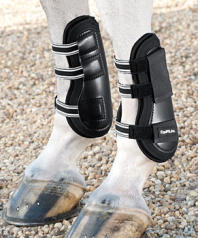 Just as the name suggests, these boots are open in the front and are used when jumping. Open-front jumping boots are intended to protect a horse’s legs from overreaching from the hind, and from brushing strikes on his inner front legs. They are open in the front to help a horse be more “careful” when jumping. The horse will feel if they knock a rail due to the open front design. However, the protection around the back of the leg protects the tendons from being struck by a back hoof, including the fetlock area. These boots are made of synthetic materials or leather.
Just as the name suggests, these boots are open in the front and are used when jumping. Open-front jumping boots are intended to protect a horse’s legs from overreaching from the hind, and from brushing strikes on his inner front legs. They are open in the front to help a horse be more “careful” when jumping. The horse will feel if they knock a rail due to the open front design. However, the protection around the back of the leg protects the tendons from being struck by a back hoof, including the fetlock area. These boots are made of synthetic materials or leather.
Usually, open-front jumping boots are worn on the front legs, with ankle boots in the back. Ankle boots protect the hind legs from brushing injuries without providing support or protection to the entire cannon bone and tendons. These two type of boots are acceptable in the jumper show ring but are not allowed in the hunter ring.
Dressage/Flatwork Boots
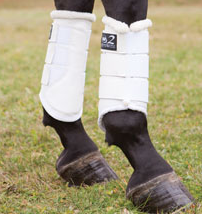 As an alternative to polo wraps, some Dressage riders use boots to support and protect their horse’s legs from interference. Traditionally these are white or black. You will often see Dressage riders schooling or warming up in boots or white polo wraps; however, neither of these is allowed in the show ring. If your horse does not interfere with his stride, you would not need to ride in boots for flatwork.
As an alternative to polo wraps, some Dressage riders use boots to support and protect their horse’s legs from interference. Traditionally these are white or black. You will often see Dressage riders schooling or warming up in boots or white polo wraps; however, neither of these is allowed in the show ring. If your horse does not interfere with his stride, you would not need to ride in boots for flatwork.
Compared to galloping boots, Dressage boots generally have more padding such as fleece or neoprene.
As riders train for higher levels of Dressage, it can be a good idea to use wraps or boots to protect your horse’s legs as he learns more difficult maneuvers.
Support Boots/Sport Medicine Boots (SMBs)
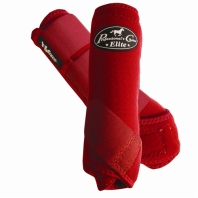 Sport Medicine Boots are intended to support the tendons and prevent over-stretching. They wrap all the way around the legs, including the fetlock, and are secured with Velcro. Like polo wraps, these should be applied firmly with even pressure, but over-tightening should be avoided. You should be able to slide a finger in between the boot and the horse’s leg.
Sport Medicine Boots are intended to support the tendons and prevent over-stretching. They wrap all the way around the legs, including the fetlock, and are secured with Velcro. Like polo wraps, these should be applied firmly with even pressure, but over-tightening should be avoided. You should be able to slide a finger in between the boot and the horse’s leg.
SMBs are designed to absorb impact when the hoof hits the ground. They also provide some protection against strikes from the horse’s hooves or an object like a jump pole. However, they do not provide as much protection as some of the other types of boots. These are often used for horses who have had tendon or ligament injuries such as suspensory injuries.
Bell Boots
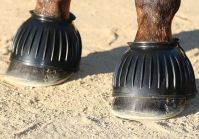 Horses that overreach from the hind are in danger of cutting the backs of their front legs, or even pulling off their own front shoes. Bell boots go over the horse’s hoof and coronet area to protect them from striking injuries. Horses who overreach are often turned out in bell boots. You can find many different styles, including ones with Velcro closures in the front. Be sure to find a bell boot that fits properly and does not cause rubs or sores, especially if your horse will wear them for a prolonged period of time such as during turnout.
Horses that overreach from the hind are in danger of cutting the backs of their front legs, or even pulling off their own front shoes. Bell boots go over the horse’s hoof and coronet area to protect them from striking injuries. Horses who overreach are often turned out in bell boots. You can find many different styles, including ones with Velcro closures in the front. Be sure to find a bell boot that fits properly and does not cause rubs or sores, especially if your horse will wear them for a prolonged period of time such as during turnout.
Things to Consider
We want to protect our horse’s legs, but it’s important to realize when you truly need boots and when you may not. Boots and wraps increase the heat in your horse’s legs, and add more weight as well. Intense heat can cause damage – including cell death in the tendons – and adding weight increases the amount of stress and energy it takes for your horse to perform. You must also be careful not to restrict your horse’s movement or damage their soft tissue by putting boots or wraps on too tightly or unevenly. On the other hand, wraps or boots that are too loose can slip and cause your horse to trip or spook. Firm, steady tension should be used as you apply wraps or boots – and it takes lots of practice.
So, to boot or not to boot? To make an informed decision, simply ask yourself: what do I need a boot to do? Then you can choose the proper boot or wrap from there. A good rule of thumb is that if boots or wraps are not necessary for your horse or the exercises you intend to do during your ride, then do not use them.
Do you use boots or wraps when you ride? What are your favorite brands or styles?
My favorite ‘look’ is the leather open front boots! That said, I really struggle with what types of boots to put my mare in. At the moment she is going in some really basic fleece lined front boots, but I’m not sure how I feel about them yet. I LOVE bell boots though, greatest things to have if your horse oversteps a lot, or can’t keep her shoes on!
LikeLike
Other than overreaching, what issue are you looking to correct or protect against? That’s a good place to start when choosing the most useful boot!
LikeLike
This was a great write up!! I’m so old-fashioned when it comes to boots… I dislike how much they heat up legs, so I almost never, ever use them. I use to polo wrap all of the time as a kid, but why? Because I liked the way it looked… oh, great reason…
I used bell boots a lot when Wiz was really green because he would trip on himself, but after he learned to use his body correctly I took them off since he doesn’t have shoes. I rarely use any kind of boot for jumping or flat work- although IF we do get to more advanced dressage moves, I may re-think that one day. For now, I only use shipping boots and brushing boots for xc and xc schooling. I don’t even poultice… I’ve read so many things about how that’s actually really bad for the horse that I just hose him off with cold water, make sure to walk him out good, and add topical liniment and so far I’ve had nothing but tight, cold and sound legs. The one time I did use standing wraps, he was swollen the next morning! My vet says standing wraps actually cause the legs to lose the ability to pump out the fluid on their own. So unless there’s a real medical reason for it, I’m feeling OK with my decision not to use them at events, even though it seems like a fad to use them!
But again, great post 🙂
LikeLike
Thanks! I’m with you – I prefer not to use much of anything. I do use polo wraps when I’m going into a lesson when I know we’ll be jumping a lot, because I’ve had horses catch – and break – wooden poles between their legs, so I like having that extra protection. I think you’re totally right-on that if you don’t need anything and your horse is sound and happy, then don’t use it just because it’s there.
LikeLike
I’m the opposite – I’d rather over-boot than under-boot (if that’s even a term…). My greenie hurt herself a couple of times during jumping, once just with a painful bruise and once with a splint. I started booting her and not a single exercise-related injury since.
Especially in very deep or very hard surfaces I like to boot just to give the legs a little extra protection and support; usually wrapping the legs for flatwork or lunging and then putting on boots for jumping. Brushing boots don’t sit well with me except for a horse that actually brushes – and then open-front boots seem to give pretty much the same amount of protection. For an overreacher, I’ll add bell boots, too. That said, I’m also pretty wary of stable bandages. If a horse is stocking up my theory is that there’s something amiss, whether it’s lack of turnout time or insufficient cooling off after exercise.
As an interesting aside, here in Africa we have most of these types of boots and call them by completely different names. Polos are known as exercise bandages and usually made of a stretchy material instead of fleece. Open-front jumping boots are called tendon boots, shipping boots are called travelling boots, and bell boots are called overreach boots. Stable bandages, medicine boots and brushing boots are the same, though.
LikeLike
It sounds like you’ve definitely found the “secret sauce” for wrapping/booting your horse. It’s obviously not a one-size-fits-all approach, and we all just want to make sure we’re doing the best we can to care for our horses.
That is super interesting that the boots have different names in Africa! I know some of them have different names in the UK as well.
LikeLike
I’m more of an under-booter myself. But if I appreciate this informative post for future when I’m doing some more serious work with my horses. 🙂
LikeLike
For sure. It’s always good to know what’s available and what they can help with!
LikeLike
Just a head’s up, most dressage boots do NOT provide support-they are merely glorified splint boots. The stretchy “dressage wrap boots” claim to provide support, but I am skeptical. :p
That said, I do use bell boots on my horse pretty much every ride…he’ll overreach once in awhile, and having dealt with pulled shoes, I’d just rather avoid that! I usually only use splint or open fronts when jumping, or sometimes if I’m doing a lot of lateral work. I think it’s generally a good idea to use boots when jumping, and I would never go bare for xc.
LikeLike